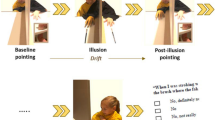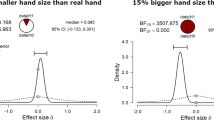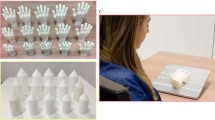Abstract
We rely on accurate body representations to successfully interact with the environment. As adults, we rely on many years of experience with a body that has stayed relatively the same size. Children, however, go through periods of rapid growth and whether or not their body representation matches this physical growth is unknown. To address this question, we examined the developmental trajectory of the body model of the hand. The body model is the representation of our bodies that underlies position sense. We recruited a group of children (8–16 years) and a control group of young adults (18–26 years) and asked them to complete the body model task. In this task, participants estimated the location of ten different landmarks (the tips and metacarpophalangeal joints of each of their five fingers). The position (XY location) of each estimate was tracked using an Optotrak camera. From the XY locations we derived hand width and finger length. Not surprisingly, children’s physical hand width and finger length were smaller than adults but remarkably, the body model, was similar for both groups. This result indicates that children overestimate hand size and suggests that the body model is ahead of physical growth. This result contradicts the notion that body representation lags physical growth during puberty, accounting for the clumsy motor behaviour characteristic of teens. We discuss the results in relation to the different taxonomies of body representation and how an enlarged representation of the hand during childhood may influence action.






Similar content being viewed by others
Data availability
Data will be made available upon reasonable request.
References
Cardinali L, Serino A, Gori M (2019) Hand size underestimation grows during childhood. Sci Rep 9(1):1–8
Chen F-C, Pan C-Y, Chu C-H, Tsai C-L, Tseng Y-T (2020) Joint position sense of lower extremities is impaired and correlated with balance function in children with developmental coordination disorder. J Rehabil Med 52(8):1–9
Cocchini G, Galligan T, Mora L, Kuhn G (2017) The magic hand: plasticity of mental hand representation. Q J Exp Psychol. https://doi.org/10.1177/1747021817741606
Coelho LA, Gonzalez CL (2017) The visual and haptic contributions to hand perception. Psychol Res 82:1–10
Coelho LA, Gonzalez CL (2018) Chubby hands or little fingers: sex differences in hand representation. Psychol Res 83:1–8
Coelho LA, Zaninelli G, Gonzalez CL (2016) A kinematic examination of hand perception. Psychol Res 81:1–8
Coelho LA, Schacher JP, Scammel C, Doan JB, Gonzalez CL (2019) Long-but not short-term tool-use changes hand representation. Exp Brain Res 237(1):137–146
de Haan AM, Smit M, Van der Stigchel S, Keyner SA, Dijkerman HC (2018) Body representation does not lag behind in updating for the pubertal growth spurt. J Exp Child Psychol 175:48–66
De Vignemont F (2010) Body schema and body image—pros and cons. Neuropsychologia 48(3):669–680
De Vignemont F (2011) Bodily awareness. In: Zalta EN (ed.), The stanford encyclopedia of philosophy (summer 2016 edition) (2016)
Dijkerman HC, De Haan EH (2007) Somatosensory processing subserving perception and action: Dissociations, interactions, and integration. Behav Brain Sci 30(2):224–230
Erdfelder E, Faul F, Buchner A (1996) GPOWER: a general power analysis program. Behav Res Methods Instrum Comput 28(1):1–11
Flindall J (2017) On action intent: behavioural correlates of reach-to-grasp actions. University of Lethbridge, Dept. of Neuroscience, Lethbridge
Frassinetti F, Maini M, Romualdi S, Galante E, Avanzi S (2008) Is it mine? Hemispheric asymmetries in corporeal self-recognition. J Cogn Neurosci 20(8):1507–1516
Frassinetti F, Maini M, Benassi M, Avanzi S, Cantagallo A, Farnè A (2010) Selective impairment of self body-parts processing in right brain-damaged patients. Cortex 46(3):322–328
Frassinetti F, Fiori S, D’Angelo V, Magnani B, Guzzetta A, Brizzolara D, Cioni G (2012) Body knowledge in brain-damaged children: a double-dissociation in self and other’s body processing. Neuropsychologia 50(1):181–188
Gallagher S, Cole J (1995) Body image and body schema in a deafferented subject. J Mind Behav 16:369–389
Giurgola S, Bolognini N, Nava E (2020) Perceptual representation of own hand size in early childhood and adulthood. Sci Rep 10(1):1–9
Gori M, Del Viva M, Sandini G, Burr DC (2008) Young children do not integrate visual and haptic form information. Curr Biol 18(9):694–698
Head H, Holmes G (1911) Sensory disturbances from cerebral lesions. Brain 34(2–3):102–254
Hirtz P, Starosta W (2002) Sensitive and critical periods of motor co-ordination development and its relation to motor learning. J Hum Kinet 7:19–28
Hu Y, Goodale M (2000) Grasping after a delay shifts size-scaling from absolute to relative metrics. J Cogn Neurosci 12(5):856–868
Hu Y, Eagleson R, Goodale M (1999) The effects of delay on the kinematics of grasping. Exp Brain Res 126(1):109–116
Jakobson L, Goodale MA (1991) Factors affecting higher-order movement planning: a kinematic analysis of human prehension. Exp Brain Res 86(1):199–208
Linkenauger SA, Witt JK, Bakdash JZ, Stefanucci JK, Proffitt DR (2009) Asymmetrical body perception: a possible role for neural body representations. Psychol Sci 20(11):1373–1380
Longo MR, Haggard P (2010) An implicit body representation underlying human position sense. Proc Natl Acad Sci U S A 107(26):11727–11732. https://doi.org/10.1073/pnas.1003483107
Longo MR, Haggard P (2012) A 2.5-D representation of the human hand. J Exp Psychol Hum Percept Perform 38(1):9–13. https://doi.org/10.1037/a0025428
Longo MR, Mattioni S, Ganea N (2015) Perceptual and conceptual distortions of implicit hand maps. Front Hum Neurosci 9:656. https://doi.org/10.3389/fnhum.2015.00656
Mackrous I, Proteau L (2016) Visual online control of goal-directed aiming movements in children. Front Psychol 7:989
Missiuna C, Rivard L, Bartlett D (2003) Early identification and risk management of children with developmental coordination disorder. Pediatr Phys Ther 15(1):32–38
Nelson EL, Gonzalez SL, Coxe S, Campbell JM, Marcinowski EC, Michel GF (2017) Toddler hand preference trajectories predict 3-year language outcome. Dev Psychobiol 59(7):876–887
Paillard J (1999) Body Schema and body image-a double dissociation. Motor control, today and tomorrow: 197–214
Petrini K, Caradonna A, Foster C, Burgess N, Nardini M (2016) How vision and self-motion combine or compete during path reproduction changes with age. Sci Rep 6(1):1–10
Peviani V, Bottini G (2018) The distorted hand metric representation serves both perception and action. J Cogn Psychol 30(8):880–893
Proske U, Gandevia SC (2012) The proprioceptive senses: their roles in signaling body shape, body position and movement, and muscle force. Physiol Rev 92(4):1651–1697
Sacrey LAR, Arnold B, Whishaw IQ, Gonzalez CL (2013) Precocious hand use preference in reach-to-eat behavior versus manual construction in 1-to 5-year-old children. Dev Psychobiol 55(8):902–911
Saulton A, Dodds TJ, Bülthoff HH, de la Rosa S (2015) Objects exhibit body model like shape distortions. Exp Brain Res 233(5):1471–1479
Saulton A, Longo MR, Wong HY, Bülthoff HH, de la Rosa S (2016) The role of visual similarity and memory in body model distortions. Acta Physiol 164:103–111
Sörös P, Knecht S, Imai T, Gürtler S, Lütkenhöner B, Ringelstein EB, Henningsen H (1999) Cortical asymmetries of the human somatosensory hand representation in right-and left-handers. Neurosci Lett 271(2):89–92
Steinsbekk S, Klöckner CA, Fildes A, Kristoffersen P, Rognsås SL, Wichstrøm L (2017) Body size estimation from early to middle childhood: stability of underestimation, BMI, and gender effects. Front Psychol 8:2038
Tanner JM (1962) Growth at adolescence. Blackwell Scientific Publications, Oxford, 1955
Tseng Y-T, Tsai C-L, Chen F-C, Konczak J (2018) Wrist position sense acuity and its relation to motor dysfunction in children with developmental coordination disorder. Neurosci Lett 674:106–111
Tseng Y-T, Tsai C-L, Chen F-C, Konczak J (2019) Position sense dysfunction affects proximal and distal arm joints in children with developmental coordination disorder. J Mot Behav 51(1):49–58
Van der Looven R, Deschrijver M, Hermans L, De Muynck M, Vingerhoets G (2021) Hand size representation in healthy children and young adults. J Exp Child Psychol 203:105016
Visser J, Geuze RH, Kalverboer AF (1998) The relationship between physical growth, the level of activity and the development of motor skills in adolescence: differences between children with DCD and controls. Hum Mov Sci 17(4–5):573–608
Wark B, Lundstrom BN, Fairhall A (2007) Sensory adaptation. Curr Opin Neurobiol 17(4):423–429
Weill-Duflos A, Sakr S, Haliyo S, Régnier, S (2020) Evidence of Sensory Adaptation to Kinaesthetic Sensations in the Human Somatosensory System. Paper presented at the 2020 IEEE Haptics Symposium (HAPTICS)
Author information
Authors and Affiliations
Corresponding author
Ethics declarations
Conflict of interest
On behalf of all authors, the corresponding author states that there is no conflict of interest.
Additional information
Communicated by Melvyn A. Goodale.
Publisher's Note
Springer Nature remains neutral with regard to jurisdictional claims in published maps and institutional affiliations.
Rights and permissions
About this article
Cite this article
Coelho, L.A., Gonzalez, C.L.R. Growing into your hand: the developmental trajectory of the body model. Exp Brain Res 240, 135–145 (2022). https://doi.org/10.1007/s00221-021-06241-2
Received:
Accepted:
Published:
Issue Date:
DOI: https://doi.org/10.1007/s00221-021-06241-2




